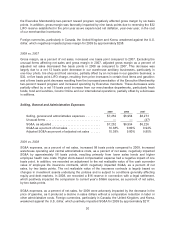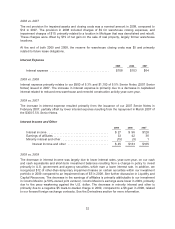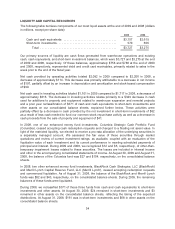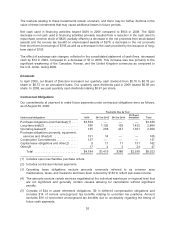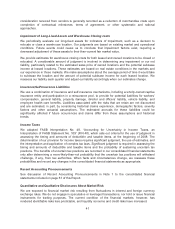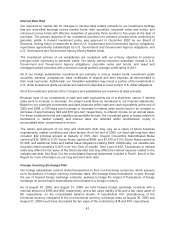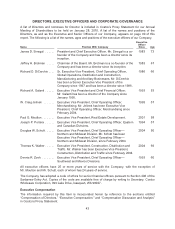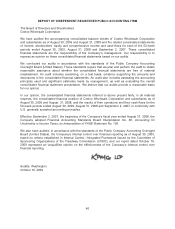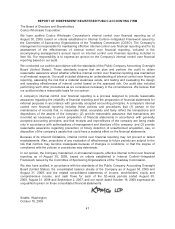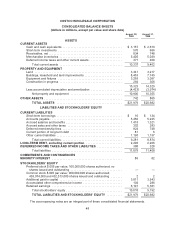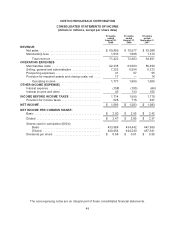Costco 2009 Annual Report Download - page 42
Download and view the complete annual report
Please find page 42 of the 2009 Costco annual report below. You can navigate through the pages in the report by either clicking on the pages listed below, or by using the keyword search tool below to find specific information within the annual report.We evaluate the criteria of the FASB Emerging Issues Task Force (EITF) 99-19, “Reporting Revenue
Gross as a Principal Versus Net as an Agent,” in determining whether it is appropriate to record the
gross amount of merchandise sales and related costs or the net amount earned as commissions.
Generally, when we are the primary obligor, subject to inventory risk, have latitude in establishing
prices and selecting suppliers, influence product or service specifications, or have several but not all of
these indicators, revenue is recorded on a gross basis. If we are not the primary obligor and do not
possess other indicators of gross reporting as noted above, we record the net amounts as
commissions earned, which is reflected in net sales.
Membership fee revenue represents annual membership fees paid by substantially all of our members.
We account for membership fee revenue on a deferred basis, whereby revenue is recognized ratably
over the one-year membership period.
Our Executive members qualify for a 2% reward (which can be redeemed only at Costco warehouses),
up to a maximum of $500 per year, on all qualified purchases made at Costco. We account for this 2%
reward as a reduction in sales, with the related liability being classified within other current liabilities.
The sales reduction and corresponding liability are computed after giving effect to the estimated impact
of non-redemptions based on historical data.
Investments
Investments are reviewed quarterly for indicators of other-than-temporary impairment. This
determination requires significant judgment. In making this judgment, we employ a systematic
methodology that considers available quantitative and qualitative evidence in evaluating potential
impairment of our investments. If the cost of an investment exceeds its fair value, we evaluate, among
other factors, general market conditions, the duration and extent to which the fair value is less than
cost, and our intent and ability to hold the investment. We also consider specific adverse conditions
related to the financial health of and business outlook for the issuer, including industry and sector
performance, operational and financing cash flow factors, and rating agency actions. Once a decline in
fair value is determined to be other-than-temporary, an impairment charge is recorded and a new cost
basis in the investment is established. If market, industry, and/or issuer conditions deteriorate, we may
incur future impairments.
Merchandise Inventories
Merchandise inventories are valued at the lower of cost or market, as determined primarily by the retail
inventory method of accounting, and are stated using the last-in, first-out (LIFO) method for
substantially all U.S. merchandise inventories. Merchandise inventories for all other foreign operations
are primarily valued by the retail inventory method of accounting and are stated using the first-in,
first-out (FIFO) method. We believe the LIFO method more fairly presents the results of operations by
more closely matching current costs with current revenues. We record an adjustment each quarter, if
necessary, for the expected annual effect of inflation, and these estimates are adjusted to actual
results determined at year-end. At the end of 2008, due to overall net inflationary trends, merchandise
inventories valued at LIFO were lower than the FIFO value, resulting in a $32 charge to merchandise
costs. During 2009, due to overall deflationary trends, we recorded a $32 benefit to merchandise costs
to adjust inventories valued at LIFO. At the end of 2009 and 2007, merchandise inventories valued at
LIFO approximated FIFO after considering the lower of cost or market principle.
We provide for estimated inventory losses between physical inventory counts as a percentage of net
sales. The provision is adjusted periodically to reflect results of the actual physical inventory counts,
which generally occur in the second and fourth quarters of the year.
Inventory cost, where appropriate, is reduced by estimates of vendor rebates when earned or as we
progress toward earning those rebates, provided they are probable and reasonably estimable. Other
40


